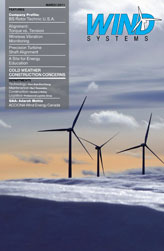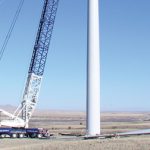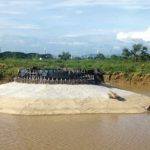In recent years we have seen the use of wind power generation continue to increase as a viable energy solution. With this increase operators are looking for the best ways to maintain wind turbines and prevent failure. There are several ways to monitor a complex power-generation system such as a wind turbine. However, one of the largest indicators of a potential problem is vibration, which is often detected in the nacelle. If a turbine is experiencing a high amount of turbulence vibration it can be a precursor to complete turbine failure, potentially resulting in explosions, turbine blades flying hundreds of yards, and toppling towers.
Think of wind turbines as mini jet engines inside of housings that run 250 feet tall. If there is any sign that something might be going wrong in the turbine, vibration is typically one of the best places to start, as it’s a good way to look at the general health of the wind turbine and see if things are functioning the way operators are expecting. The quicker that operations and maintenance (O&M) teams can detect problem signals, the sooner that loss can be mitigated and potential disasters avoided. There’s a lot of value in vibration monitoring because it gives more predictive ability for the O&M company and the O&M technicians to look for problems before they come up. The danger in not monitoring for potential issues could result in a loose blade. A vibration reading will signal the operator before the blade actually becomes loose, preventing damages in the $2-$5 million range.
Vibration Monitoring Solutions
A common solution for monitoring is a wired, or cable solution (Figure 1). However, many operators are finding that installing additional wire is not feasible. This is mostly due to remotely located turbines and the high costs associated with installing/running additional wire. Sometimes it’s simply not possible to run wire back to the O&M office.
Recently, wireless technologies have become an option for various monitoring applications in the renewable industries. Satellite systems, for example, have broadband capabilities and tend to be reliable, but they have monthly recurring costs. Cell phone systems function in a similar fashion as satellite systems, using an existing network of communication devices with associated monthly charges. If users are within range of a cell tower, cell phone systems are a simple solution for sending data back to the O&M office, but the monthly recurring costs associated with satellite or cell phone systems can become a burden on an operating budget.
Now operators can also choose Frequency Hopping Spread Spectrum (FHSS) radios to send critical vibration-sensing data to the O&M office, without the added cost of fiber installation and without the monthly or reoccurring fees that tend to accompany cellular and satellite solutions. This class of wireless radios has proven its reliability in industries such as military, oil and gas, and water/wastewater, and it is now available as a solution for vibration monitoring in wind turbines (Figure 2). Ideal for installation in remote locations and difficult environments, they can transmit real-time data up to 60 miles line-of-sight reliably.
Why Wireless?
Wind turbines are huge investments, costing millions of dollars. Many are nearing the end of their warranties, which typically last about 20 years. Operators are being proactive about detecting problems in the turbines before the warranty period expires. This has become a great opportunity to install wireless technologies. In order to inspect the turbines for problems, an operator will physically go up and into the turbine looking for potential problems. While they are performing the inspection they can easily install a FHSS wireless data radio and monitor the turbine on a real-time basis.
Cost is another driving force for deploying wireless technologies. FHSS radios are generally much less expensive to install than cable and do not have the reoccurring fees of satellite and cell phone technologies. In addition, if the operator can stop a turbine from a potential disaster by detecting problems before they happen, they can save millions of dollars. With some wireless data radio providers the investment in an RF network isn’t only useful for vibration monitoring. The devices can be scaled to monitor wind speed coming from an anemometer, or the RPM of the actual engine itself within the turbine. With these radios, they can be expanded upon without having to add more devices.
Another main driver of wireless implementation is field scalability. Many wireless modems have multiple data ports that can be utilized in the future when additional instrumentation is needed (Figure 3), or if existing devices—lubrication particulate sensors, inverter monitors, in-tower data loggers—need to be accessed remotely later on in the life of the field. And because many RF devices are Ethernet-enabled, expanding on an existing radio network is as easy as assigning a new IP address to a new radio and installing it uptower, which shouldn’t take longer than an hour or two.
Real-World Example
A wind power company in the Southwestern United States along the Texas/New Mexico border needed a vibration monitoring solution for dozens of turbines. In this case the property owner and site operator did not want the contracting company to use their existing fiber optic network. They also didn’t have the bandwidth or the ability to use their existing fiber optic network to set up the system. So, the question became “how are we going to get vibration sensing data from the turbine back to the O&M office if we can’t use the existing fiber optic network that the site operator installed?”
Fiber optic networks are typically installed at the same time as the turbines. They consist of large webs of fiber optic cable that send and receive data all the time. They are very high-throughput and prepared for this type of application from an industrial standpoint, but in this particular case the company did not have the option to use fiber. They began looking at several wireless providers and settled on one that offers FHSS wireless data radios.
There is a class of FHSS wireless data radios that have proven to succeed even in the most difficult environments. In this particular installation all the turbines sat on top of a mesa, which offered a clear line of site. Both pier-to-pier communication and point to multi-point communication was very easy to achieve. However, each one of the turbines is composed of a mast that is about 200 feet tall by 15-20 feet in diameter and is made of corrugated steel. This could have easily created an issue with line-of-sight. There was a concern that RF would reflect off the turbines like a mirror.
Operators should always work with a wireless company that provides path studies or lender radios to ensure the products will work before they purchase them. In this situation, the tests showed that the wind turbines would not be an issue. When the wind power company did the path study it compared multiple radios, and it was able to determine which ones performed despite the potential obstruction of the huge wind turbines. One of the radios in the comparison would lose data each time a blade passed through the arc link, so they went with the solution that did not have link issues.
The chosen radio provider took the potential obstruction into consideration before installing the radios. In this case they conducted a study using a digital elevation level to indicate potential issues. That was only one way to account for the huge obstruction, however, so it was a bit of a variable. The radio provider did some additional testing by physically climbing to the top of a cell and setting up a radio inside the housing. The signal transmitted through the turbine back to the O&M office without a hitch.
Now that the FHSS wireless data radios have been deployed at this location, most of the vibration monitoring occurs inside the nacelle. In addition, vibration monitoring also occurs on the couplings that the turbine blades feed into, and on the blades themselves. There could be two dozen vibration-sensing accelerometers feeding their data back to a condition monitoring box on any single wind turbine. The accelerometers send data through a FHSS wireless data radio, which reports back to the O&M building that is central to the wind farm. Basically, the radios act like an Ethernet bridge to send and receive vibration data going through the entire network. Each turbine is reporting their vibration data roughly twice a day, sometimes three times a day, and has been doing so successfully for several months.
The deployment of these radios has been such a success that there are 11 different sites planned for installation in the next year and a half. The company is looking to install 450-500 more radios across the country.
Software Advantages
Some FHSS wireless data radios are accompanied by software programs that not only help with configuration, but offer diagnostics (Figure 4). Not all providers offer this type of solution, but it is something that O&M should take into consideration as they search for the best wireless provider for their particular installation. Some diagnostics software can tell an operator which device is talking better or worse than another; if their data packets are being lost and where; and can track the traffic down to the packet. Software programs like these provide a granular understanding of the RF network; it’s actually given many operators additional transparency in their network.
Conclusion
FHSS wireless data radios can reliably serve as the Ethernet link between a wind turbine and the O&M office. As a wind power company in New Mexico found, the right wireless provider and installation can be equally effective and far less expensive than a wired solution. Reliable wireless technologies can be easily installed as operators inspect wind turbines that are nearing the end of their warranties. After deployment the turbines are continually monitored on a real-time basis, indicating issues with vibration before they cause devastating damage. As operators learn of successful wireless installations, they are beginning to view FHSS wireless radios as a viable option for vibration monitoring. Now many radio providers offer the option of path studies, diagnostic software, and industrially hardened products that have proven their performance in other industries.








































